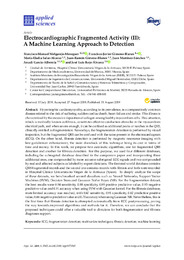Por favor, use este identificador para citar o enlazar este ítem:
https://hdl.handle.net/11000/30604Registro completo de metadatos
| Campo DC | Valor | Lengua/Idioma |
|---|---|---|
| dc.contributor.author | Melgarejo Meseguer, Francisco Manuel | - |
| dc.contributor.author | Gimeno Blanes, Francisco Javier | - |
| dc.contributor.author | Salar Alcaraz, Mariela | - |
| dc.contributor.author | Gimeno Blanes, Juan | - |
| dc.contributor.author | Martínez-Sánchez, Juan | - |
| dc.contributor.author | García-Alberola, Arcadi | - |
| dc.contributor.author | Rojo-Álvarez, José Luis | - |
| dc.contributor.other | Departamentos de la UMH::Ingeniería de Comunicaciones | es_ES |
| dc.date.accessioned | 2024-01-24T11:21:38Z | - |
| dc.date.available | 2024-01-24T11:21:38Z | - |
| dc.date.created | 2019-08 | - |
| dc.identifier.citation | Applied Sciences Volume 9 Issue 17 (2019) | es_ES |
| dc.identifier.issn | 2076-3417 | - |
| dc.identifier.uri | https://hdl.handle.net/11000/30604 | - |
| dc.description.abstract | Hypertrophic cardiomyopathy, according to its prevalence, is a comparatively common disease related to the risk of suffering sudden cardiac death, heart failure and stroke. This illness is characterized by the excessive deposition of collagen among healthy myocardium cells. This situation, which is medically known as fibrosis, constitutes effective conduction obstacles in the myocardium electrical path, and when severe enough, it can be outlined as additional peaks or notches in the QRS, clinically entitled as fragmentation. Nowadays, the fragmentation detection is performed by visual inspection, but the fragmented QRS can be confused with the noise present in the electrocardiogram (ECG). On the other hand, fibrosis detection is performed by magnetic resonance imaging with late gadolinium enhancement, the main drawback of this technique being its cost in terms of time and money. In this work, we propose two automatic algorithms, one for fragmented QRS detection and another for fibrosis detection. For this purpose, we used four different databases, including the subrogated database described in the companion paper and incorporating three additional ones, one compounded by more accurate subrogated ECG signals and two compounded by real and affected subjects as labeled by expert clinicians. The first real-world database contains QRS fragmented records and the second one contains records with fibrosis and both were recorded in Hospital Clínico Universitario Virgen de la Arrixaca (Spain). To deeply analyze the scope of these datasets, we benchmarked several classifiers such as Neural Networks, Support Vector Machines (SVM), Decision Trees and Gaussian Naïve Bayes (NB). For the fragmentation dataset, the best results were 0.94 sensitivity, 0.88 specificity, 0.89 positive predictive value, 0.93 negative predictive value and 0.91 accuracy when using SVM with Gaussian kernel. For the fibrosis databases, more limited accuracy was reached, with 0.47 sensitivity, 0.91 specificity, 0.82 predictive positive value, 0.66 negative predictive value and 0.70 accuracy when using Gaussian NB. Nevertheless, this is the first time that fibrosis detection is attempted automatically from ECG postprocessing, paving the way towards improved algorithms and methods for it. Therefore, we can conclude that the proposed techniques could offer a valuable tool to clinicians for both fragmentation and fibrosis diagnoses support. | es_ES |
| dc.format | application/pdf | es_ES |
| dc.format.extent | 22 | es_ES |
| dc.language.iso | eng | es_ES |
| dc.publisher | MDPI | es_ES |
| dc.rights | info:eu-repo/semantics/openAccess | es_ES |
| dc.rights | Attribution-NonCommercial-NoDerivatives 4.0 Internacional | * |
| dc.rights.uri | http://creativecommons.org/licenses/by-nc-nd/4.0/ | * |
| dc.subject | ECG | es_ES |
| dc.subject | fragmentation detection | es_ES |
| dc.subject | multivariate techniques | es_ES |
| dc.subject | fibrosis detection | es_ES |
| dc.subject | machine learning | es_ES |
| dc.subject.other | CDU::6 - Ciencias aplicadas::62 - Ingeniería. Tecnología | es_ES |
| dc.title | Electrocardiographic Fragmented Activity (II): A Machine Learning Approach to Detection | es_ES |
| dc.type | info:eu-repo/semantics/article | es_ES |
| dc.relation.publisherversion | https://doi.org/ 10.3390/app9173565 | es_ES |

Ver/Abrir:
190801 Electrocardiographic Fragmented Activity II - A Machine Learning Approach to Detection applsci-09-03565-v2.pdf
972,33 kB
Adobe PDF
Compartir:
 La licencia se describe como: Atribución-NonComercial-NoDerivada 4.0 Internacional.
La licencia se describe como: Atribución-NonComercial-NoDerivada 4.0 Internacional.
.png)